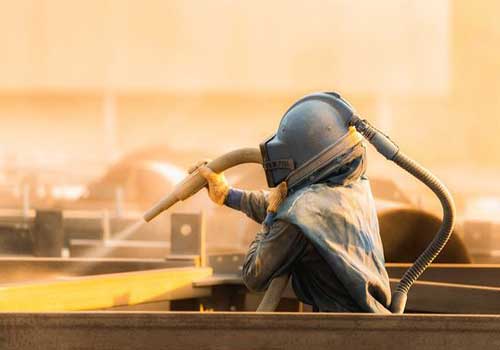
What is a blasting process?, Blasting, referred to as the blasting process, involves propelling abrasive materials against a surface to achieve tasks like cleaning, smoothing, or shaping it. This technique finds application in diverse industries for a wide range of purposes. Common uses of blasting encompass surface cleaning, preparation, deburring, shaping, profiling, and surface texturing.
Keep reading to discover the types, techniques, and applications of blasting
Do you know what is a blasting process?
As we mentioned, Blasting is a process that involves using compressed air or mechanical force to propel abrasive materials at high speeds onto a surface. The purpose of blasting is to clean, etch, roughen, or shape the surface of an object. It is commonly used in various industries for a wide range of applications, including surface preparation, cleaning, and finishing.
What is blasting used for?
Blasting is utilized for surface cleaning purposes, effectively removing contaminants, rust, old paint, or any unwanted materials from surfaces. This preparatory step ensures the surface is ready for subsequent treatments such as painting, coating, or bonding.
In industries like construction and manufacturing, blasting is employed to create a roughened or etched surface, enhancing adhesion for coatings or bonding materials. This process is known as surface preparation.
What are the types of blasting?
Numerous blasting techniques are available, each tailored to specific applications and surface materials. Among the common types of blasting are:
Sandblasting
is considered one of the most traditional and widely adopted blasting techniques. But what is the difference between sandblasting and blasting? Sandblasting specifically uses fine sand particles propelled against a surface to clean, strip paint, or remove contaminants, making it ideal for heavy-duty surface preparation and creating a rough texture for better adhesion. Other blasting methods may use different abrasive materials or techniques depending on the surface and desired finish.
Shot Blasting
Shot blasting utilizes small steel shots or abrasive particles that are forcefully propelled at high velocity onto a surface. This process is employed to clean, polish, or strengthen the surface, commonly used for preparing metal surfaces for coatings or removing scale and rust.
Abrasive Blasting
This is a broad term that includes various blasting methods employing abrasive materials such as sand, steel grit, glass beads, or aluminum oxide to clean, smooth, or shape a surface.
Soda Blasting
In this technique, baking soda (sodium bicarbonate) is utilized as the blasting media. It is a less abrasive option and is frequently applied on delicate surfaces or surfaces that cannot withstand traditional sandblasting.
Water Blasting
This method utilizes high-pressure water jets to remove contaminants or prepare surfaces. It is especially well-suited for cleaning sensitive surfaces or tasks that require effective dust control.
Dry Ice Blasting
Dry ice blasting involves propelling dry ice (solid carbon dioxide) pellets at high speed to clean surfaces. This non-abrasive method is frequently employed for cleaning sensitive equipment or removing contaminants without leaving any residue.
Bead Blasting
Bead blasting employs spherical glass or ceramic beads as the abrasive media. This method is widely used across various industries for cleaning, deburring, and surface finishing purposes.
Each type of blasting has its advantages and limitations, and the choice of blasting method depends on factors such as the surface material, the required outcome, the level of cleanliness needed, and the specific application or industry involved. Proper safety measures should always be followed during any blasting process to ensure the protection of personnel and the surrounding environment.
What are the basics of sandblasting?
At its core, sandblasting entails the forceful propulsion of abrasive materials, like sand, onto a surface using compressed air or other propellants. This process aims to clean, shape, or smooth the surface. The key elements and steps involved in the sandblasting process are as follows:
Equipment: To conduct sandblasting, specific equipment is necessary, which includes a sandblasting machine or cabinet, an air compressor, an abrasive material (typically sand), and a nozzle or gun used to direct the abrasive particles. For reliable heavy-equipment-rental-companies-in-Egypt, you can find complete rental services at CLC company.
Surface PreparationPrior to commencing the sandblasting process, it is essential to clean and prepare the surface to be treated. Removing any loose paint, rust, or contaminants is crucial to achieve effective results.
Safety Precautions: Due to the generation of dust, noise, and flying abrasive particles, it is of utmost importance to wear proper safety gear during sandblasting and painting. This includes a helmet with a visor, gloves, protective clothing, and respiratory protection to prevent inhaling dust.
Abrasive Selection: The type and size of the abrasive material used depend on the surface material and the desired outcome. Commonly used abrasives include silica sand, garnet, aluminum oxide, and crushed glass.
Adjusting Pressure: The air compressor regulates the pressure used to propel the abrasive material. The pressure level must be adjusted according to the surface material and the specific task, as excessive pressure can damage the surface.
Blasting Process: As the operator, you direct the abrasive nozzle or gun towards the target surface, maintaining control over the flow of abrasive material using a trigger. The high-force impact of the abrasive particles on the surface effectively removes paint, rust, or any other unwanted materials.
Surface Finishing: Depending on the application, the sandblasting process can be used to create different surface textures, such as roughening, smoothing, or etching.
Cleanup: After sandblasting, the removed materials and debris should be properly collected and disposed of, and the work area should be cleaned to remove any remaining abrasive particles.
Regular maintenance of the sandblasting equipment is vital to ensure its optimal performance and safety for future applications.
What materials are used in blasting?
In blasting processes, a variety of abrasive materials are used depending on the specific application, surface type, and desired outcome. These materials are solid particles, not chemicals, that are propelled at high speed to impact and treat surfaces safely and effectively. Choosing the right abrasive is crucial to achieve the best results while protecting both the surface and personnel.
Common abrasive materials include:
- Sand: Silica sand is one of the most traditional and widely used abrasives, ideal for sandblasting and heavy-duty surface preparation.
- Steel Grit & Steel Shot: Small steel particles used in shot blasting to clean, strengthen, and prepare metal surfaces.
- Glass Beads: Spherical beads for delicate surface cleaning and finishing.
- Aluminum Oxide: Aggressive abrasive for surface cleaning, etching, and preparing metals.
- Garnet: Natural mineral suitable for various surfaces and applications.
- Crushed Walnut Shells: Gentle abrasive for softer materials and surfaces.
- Baking Soda (Sodium Bicarbonate): Mild abrasive for cleaning sensitive surfaces and removing contaminants.
- Dry Ice: Solid CO₂ pellets used for non-abrasive cleaning without leaving residue.
- Plastic Media: For delicate surfaces where traditional abrasives could cause damage.
- Ceramic Beads: Used for deburring and surface finishing in industrial applications.
Each abrasive type offers unique effects and must be selected according to surface material, project requirements, and safety considerations. Following strict safety protocols ensures optimal performance and protects both operators and the treated surfaces during blasting operations.
For professional blasting services, including surface preparation, cleaning, and finishing, contact Capital Leading Company CLC today to get expert solutions for your industry.


